A Portrait of The Wine as a Grape: The Pure Expression of Alsace’s Varietal Wines Domaine Schoffit in Six Grapes (6-Bottle Pack $189) + Alsace: Under Pressure (3-Bottle Pack $110)
If you’re ever called upon to distill the essence of Alsatian wine into a single, simplistic phrase, you might say: ‘German varietals done in French styles.’
Of course, like Alsace itself, nothing about wine is simple, and it’s a fact that Alsace produces some of the most complex and thought-provoking wines of any region on earth. But on the surface, the summation is absolutely accurate; the territory’s French/German connection is forged in history. These two European neighbors have struggled over possession of Alsace since 357 AD.
Located on the west bank of the upper Rhine next to Germany and Switzerland, the region has switched hands between France and Germany four times since 1870, so it’s no surprise that the cultural underpinnings of the region have one foot in France and the other in Germany, and that their food and wine traditions follow the split-personality scheme. Culinary Alsace is an Alemannic and Frankish melting pot, with popular dishes including Baeckeoffe, Flammekueche, Choucroute, Cordon bleu and Vol-au-vent, while the seven grapes legally allowed for wine production in Alsace are the Germanic standbys—Pinot Blanc, Sylvaner, Riesling, Muscat, Pinot Gris, Gewürztraminer and the only red wine produced in Alsace, Pinot Noir. Alsatian alchemy transforms these familiar stand-by varietals into rich, balanced, often ethereal incarnations, from intensely aromatic and crispy dry versions, to the mellow, sweet Vendange Tardive (late harvest) and Sélection de Grains Nobles, to the sparkling Crémant d’Alsace—a slightly sparkling wine produced with the traditional Champagne method of secondary fermentation inside the bottle and representing a quarter of all Vins d’Alsace production.
So intense and beautiful are these wines that they frequently remind us of Cinderella: varietals that may elsewhere be plain and plebian, born to clean chimneys in other wine regions, but who don their full Princess Ball regalia in Alsace.
This week’s package includes six bottles from Alsace’s wunderkind Bernard Schoffit, whose reclamation of an abandoned vineyard in Rangen de Thann has put him in the crosshairs of wine experts across the globe. ($189)
Additionally, superb examples of lyrical Crémant d’Alsace are available in a three-bottle pack ($110).
Alsace: A Geologist’s Dream
An Alsace cliché: ‘Walk 100 feet in any direction and you’ll find a totally different soil composition.’
The terroir of Alsace is, in fact, a mosaic of diversity; soils underlying the vineyards are a tapestry ranging from the schist and granite of the higher elevations (extending into the Vosges Mountains) to the limestone and chalk of the lower slopes and to the clay and gravel of the valley floors. However, it is the unique, reddish-colored sandstone of Alsace—known as grès des Vosges—that may be most interesting. Vosges sandstone runs in a large, horizontal swath through the range just below the granite layer from which it is derived and atop a layer of coal. Grès des Vosges is hard, compact sandstone composed mainly of quartz and feldspar. Its pink-reddish color is due to the presence of decomposing iron (iron oxide, as also seen in red soils throughout the world) that occurred as a result of the slow cooling of large masses of magma as it hardened into granite.
Most of the wine-making villages in Alsace are built on four or five different formations in a juxtaposition of often-restrained parcels, providing a montage of uniquely abundant and diverse soils. These infinite variations are the very heart of the exceptional diversity found in the Vins d’Alsace.
Seven Grapes in Search of Terroir
As we’ve seen, geologic forces some 45 million years ago resulted in thousands of feet of downward drop of the broad rift valley through which the Rhine River now flows; the soils left by these tectonic machinations is a byzantine patchwork that can vary tremendously over a very short distance. These changes profoundly affect the suitability of each patch of ground for a particular grape variety.
Thus, Gewürztraminer is grown on the sandstone soils of the Kitterlé vineyard while profound Rieslings grown of the granitic soils of the Sommerberg. Refined Sylvaners grow on the limestone of the Zotzenberg vineyard, Pinot Blanc prefers rich, deep soil and Muscat fairs best on marl and sandstone. So well-matched is situation to varietal that unlike elsewhere in France, that by law and tradition, Alsace labels wine with grape variety first and by geographic location as an afterthought.
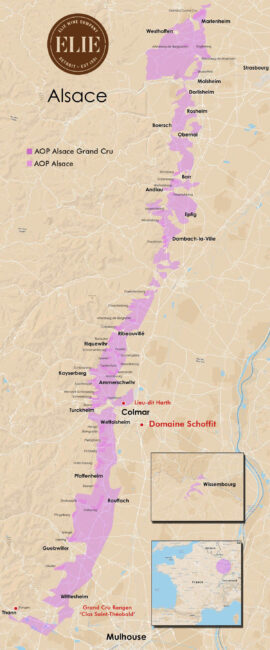
The Enigma of The Grand Crus
Among the assorted anomalies that makes Alsace unique in France is a somewhat ambivalent attitude toward its own Grand Crus. Although there are 51 of them, not every producer or even every Grand Cru is happy with the restrictive, creativity-squashing rules that bind them. For example, with very few exemptions, Alsace Grand Cru must be a white wine produced 100% from a single variety of the four ‘Noble’ grapes—Riesling, Gewürztraminer, Pinot Gris or Muscat, which may be Muscat Ottonel, Blanc à Petits Grains, and/or Rosé à Petits Grains variations. Alsace Grand Cru wines must be vintage dated, cannot be released until June 1 of the year following harvest and are required to be bottled in a traditional Flûte d’Alsace. Vendange Tardive (late harvest) and Sélection de Grains Nobles (botrytis-affected) wines must be hand-harvested and require an additional year of aging.
Generally located at altitudes between 650 and 1300 feet, where grades are often quite steep, Grand Crus benefit from distinguishing soils as well as exposures and micro-climates that promote slow, consistent grape maturation—a key factor in developing the finely expressed aromas of Alsace wines.
As noted, among the exceptions to the ‘100%’ rule is Altenberg de Bergheim, located in the hills above the commune of Bergheim in the Haut-Rhin. It is the only Alsace Grand Cru wine allowed to contain Pinot Noir, and blends must be 50-70% Riesling, 10-25% Pinot Gris, 10-25% Gewürztraminer and may contain up to 10% (combined) Chasselas, Muscat (à Petits Grains or Muscat Ottonnel), Pinot Noir, and/or Pinot Blanc. Kaefferkopf Grand Cru is also allowed to produce blends, using 60-80% Gewurztraminer and 10-40% Riesling; they may also include up to 30% Pinot Gris and up to 10% Muscat.
Domaine Schoffit
Alsace’s Reclaimed Treasures
As the southernmost Grand Cru, Rangen de Thanni is a fitting ‘ciao’ to Alsace; ‘ciao’, of course, can translate to either ‘hello’ or ‘goodbye’ depending on the direction you are heading. With Bernard Schoffit, it is high time the world gave him a hearty hello and never mind the rest; he is a star who has not yet supernovaed in the wine universe, and as a result, his gems are extremely affordable.
To call a man a ‘pioneer’ who cultivates wine country that has been famous for eight hundred years (vintage 1228 was described as ‘extremely good; so hot you could fry an egg in the sand’) may seem a stretch, but the spirit that impelled Bernard Schoffit to purchase 16 acres around Clos St. Théobold belongs to a frontiersman. Previously abandoned because the slopes were deemed too steep to work, the vines in question (in Rangen de Thann AOP) grew on a plot of soil that has been likened to Montrachet and Chambertin. And from this forbidding site, relying on extremely low yields, he is making extraordinary wine with each cépage.
In addition, Schoffit raises grapes in the lieu-dit Harth, an alluvial terroir close to the commercial area of Hussen in northern Colmar, and three acres in the granitic Grand Cru Sommerberg to the south of Katzenthal and to the north of Niedermorschwihr. In Harth, Schoffit tends 80 years old Chasselas vines, of which a few percent are replanted each year as an illustration of Schoffit’s long-term perspective.
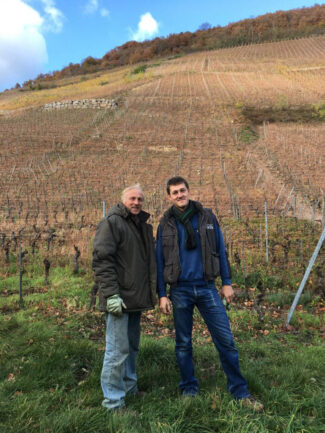
Bernard and Alexandre Schoffit, photo courtesy of Savage Selection
Based near Colmar, Bernard took the winery over from his father Robert and his son Alexandre is now a co-owner. Demonstrating the estate’s commitment to sustainable agriculture Alexandre maintains, “All our vineyards are organic, and we also started to work biodynamic a few years ago. In order to show more transparency, I decided in 2016 to launch the official certification process, but for administrative reasons it was stretched over different years. The first wines officially labeled fully organic will be some cuvées of the 2019 vintage (Harth Riesling and Harth Pinot Gris for example), and the rest of the classic range will follow in the 2020 vintage. For the Grand Crus, it will be from the 2022 vintage. The official certification for biodynamic is in progress and we are still waiting to know from when we will be able to use it on the labels. But for now, Domaine Schoffit gives the assurance that we are both bio and biodynamic!”
Pinot Blanc d’Alsace
‘Light, Supple and Spring-like’
Pinot Blanc is often thought of as understudy to Chardonnay (especially in Burgundy, where it is still permitted in many Grand Cru vineyards), but it takes on the diva’s role in Alsace. It is the region’s favorite mutant, the ‘white sheep’ of the Noir family since it is a genetic anomaly that originated as Pinot Noir, but with a smaller concentration of color-producing anthocyanins. Alsace puts the grape to work in the production of still, sparkling and sweet dessert wines, although it is frequently overshadowed by more popular Alsatian gems made from Gewürztraminer and Riesling.
Pinot Blanc d’Alsace frequently displays toasted almond aromas with hints of pie spice; nutmeg especially. On the palate they show a range of creamy applesauce flavors, and may display some light mineral characteristics, although these are generally muted by the oak treatment that Alsatian winemakers tend to favor.
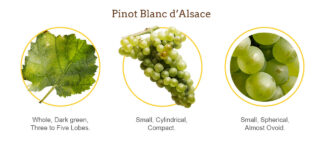
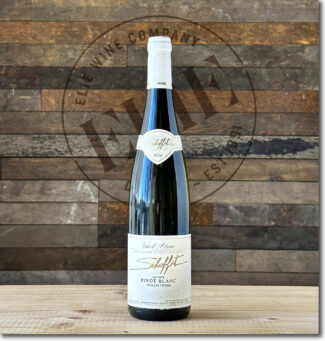 •1• Domaine Schoffit ‘Vieilles Vignes’, 2020 Alsace Pinot Blanc – Auxerrois ($20)
•1• Domaine Schoffit ‘Vieilles Vignes’, 2020 Alsace Pinot Blanc – Auxerrois ($20)
Made from 50-year-old vines, the vinification starts with gentle pressing and clarification of cool must for 48 hours. The wine displays subtle notes of yellow plum with a pure-fruit edge translating to freshness on the nose. The assemblage includes some Auxerrois, which lends stone fruit flavors and a lucid lemon-ginger zing to the mid-palate while white plum notes follow through to a mineral-driven finish.
Chesselas d’Alsace
‘Light with Discreet Fruitiness”
The main grape in the German wine Edelzwicker, Chasselas is no longer widely planted in Alsace despite its productivity, although it’s a cornerstone varietal in its homeland, nearby Switzerland, where it is the second most-planted vine.
Under normal harvest conditions Chasselas produces somewhat bland, fruity wines that do not have much longevity in the bottle. But by keeping yields low and vines thirsty, it produces smaller berries with much more concentration—a hallmark of all fine Alsace wines.
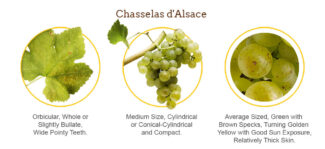
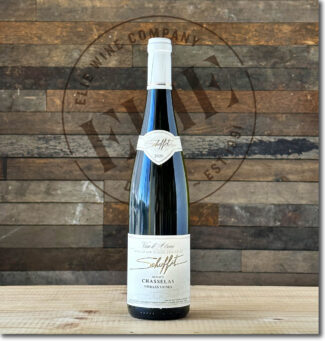 •2• Domaine Schoffit ‘Vieilles Vignes’, 2020 Alsace Chasselas ($25)
•2• Domaine Schoffit ‘Vieilles Vignes’, 2020 Alsace Chasselas ($25)
100% Chasselas. From a two-acre parcel planted in 1935 on alluvial, gravel-filled soils of gravel in Colmar; entirely hand-harvested, fermented and aged in stainless steel tanks. The wine hints of fresh and corn husk in a delightfully dry nose and palate fresh with lemon peel and peach, with a subtle undertone of Bosc pear. The finish is classically dry finish with mouthwatering salinity.
Riesling d’Alsace
‘Elegant, Fresh and Delicately Aromatic’
With little space for argument, the statement can be made that Alsace produces some of the most terroir-reflective Rieslings on earth, echoing precisely the mix of granite, limestone, schist and sandstone on which they are grown. The wine is rarely oaked and only produced in off-dry versions labeled Vendange Tardive (late harvest) or Sélection de Grains Nobles (from grapes affected by botrytis). In general, it is the most prolific grape among Alsatian vineyards, accounting for 22% of planted acreage Average annual Riesling production is about 2.8 million cases by some 950 producers.
The wines are intensely linear, and have a distinctively complex acid structure and high concentration. Aromatic and expressive, they display intense aromas of citrus, peach, pear, white flowers and a steely minerality and are particularly well-suited to aging, where the fruit recedes and yields to aromas of beeswax, lanolin, butter, smoke, pine, honey, butterscotch, mushroom, lemon candy and especially, overtones of gasoline, which is more delectable than it sounds.
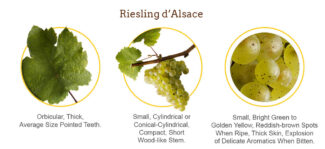
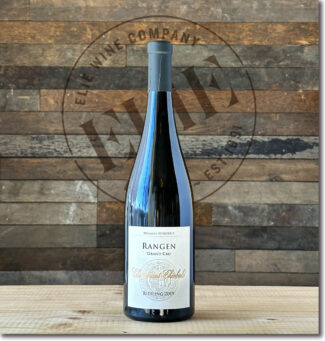 •3• Domaine Schoffit, 2019 Alsace Grand Cru Rangen ‘Clos Saint-Théobald’ Riesling ($59)
•3• Domaine Schoffit, 2019 Alsace Grand Cru Rangen ‘Clos Saint-Théobald’ Riesling ($59)
The volcanic soils of Rangen, characterized by their low clay content, lie beneath one of the warmest plots in the region, a combination that generally pushes this Grand Cru to the top of the list. At 14.3% abv, it is precise and potent in comparison to a German Riesling, showing dried peach, lemon curd, fresh lime and Rangen’s classic, slightly resinous aromas of fresh rosemary.
Gewürztraminer d’Alsace
‘Intense, exuberant and Aromatic’
If ever a grape variety can be thought of as an ‘acquired taste’, it’s Gewürztraminer, whose unctuous, oily, often musky scent is (at least) easy to recognize. It is a white wine, although the grapes themselves are pink and impart a slight tint to the juice, making it a wine identifiable not only by bouquet, but by color alone.
Gewürz performs best on the heavier, clay soils of Alsace’s Haut-Rhin department, and can quite easily attain the sort of ripeness needed for the sensational late-harvest bottlings labelled Vendange Tardive and Sélection de Grains Nobles. That said, the variety ripens so fast it needs to be planted somewhere relatively cool if it is to develop any discernible perfume but must be harvested while acid levels remain high enough to balance sugars.
Picked judiciously, Alsace Gewürztraminer ‘sec’ is pungent, dry and powerful enough to accompany rich food, and reaches heights of complexity here unmatched anywhere else in the world.
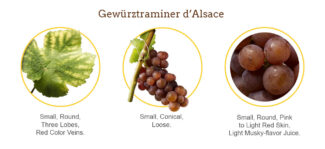
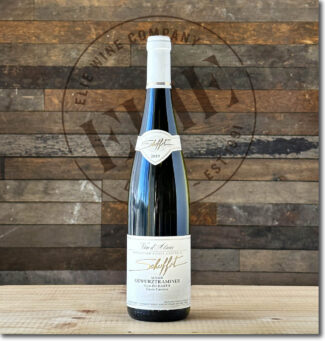 •4• Domaine Schoffit ‘Cuvée Caroline’, 2019 Alsace ‘lieu-dit Harth’ Gewürztraminer ($26)
•4• Domaine Schoffit ‘Cuvée Caroline’, 2019 Alsace ‘lieu-dit Harth’ Gewürztraminer ($26)
A classically concentrated Alsatian Gewürz, with unctuous flavors of tropical fruit, honey, pear and lychee in front of a distinct smokiness. Lengthy, fresh, and a touch bitter on the finish, with top notes of orange pith.
Pinot Gris d’Alsace
‘Generous, Ample and Full Bodied’
Another mutation within the Pinot family, Pinot Gris is a sibling of Pinot Noir and Pinot Blanc, and perhaps among the most double-faced grapes on earth: It creates the light, crisp, often forgettable Pinot Grigios of northern Italy and (without undergoing any mutations whatsoever) becomes rich and unctuous in Alsace. Location, location, location… and restricted yields.
Most identifiable by ripe poached pear notes, in Alsace the grape also reveals a floral, flinty, smoky, spicy and honeyed profile, allowing winemakers revel in the possibilities.
“In the past, Grand Cru Alsace Pinot Gris was usually made in an off-dry or sweet style, but today, it is possible to make it in a dry style,” says Alsatian winemaker Samuel Tottoli. “For me, it is necessary to vinify it dry. Low yields from stony vineyards ensure the wine is concentrated, while prime sites with well-drained soils further promote ripening before too much sugar develops in the grapes.”
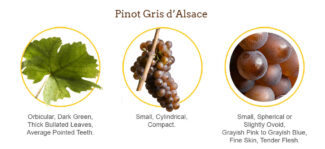
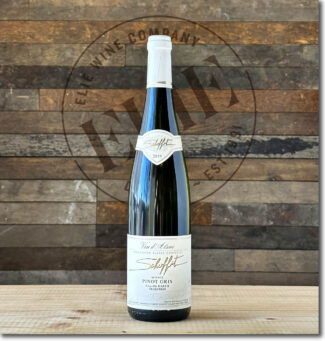 •5• Domaine Schoffit ‘Tradition’, 2019 Alsace ‘lieu-dit Harth’ Pinot Gris ($26)
•5• Domaine Schoffit ‘Tradition’, 2019 Alsace ‘lieu-dit Harth’ Pinot Gris ($26)
When the word ‘Tradition’ appears on a Schoffit label, expect a dry wine. When it reads ‘lieu-dit Harth’, it comes from a prized vineyard near Colmar and you expect a super ripe, full-bodied wine that amplifies the profile of the varietal. In this case, the pear notes that often define Pinot Gris are a symphony, with highlighted sections of bright acidity, high-toned cinnamon and gentle wood smoke. In the fourth and final movement, look for citrus, jasmine, melon and pineapple.
Pinot Noir d’Alsace
‘Full-bodied, Heady and Intensely Fruity’
Pinot Noir in Alsace—the only red wine grape permitted by AOP law—is a poster child for the upside of climate change. Once capable of producing only highly acidic, thin-bodied wine except in rare vintages, the slow creep of temperature increases throughout the region has seen a remarkable make-over for Burgundy’s pet red: Pinot Noir d’Alsace is currently producing rustic wines that showcase the varietal’s classic cherries, cranberries, strawberries and raspberries cloaked in supple, soft tannins. In the hands of top producers in particularly warm seasons, these wines are as earthy and complex as Cru Burgundy.
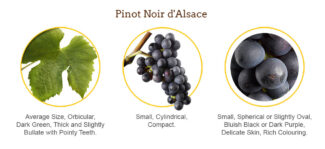
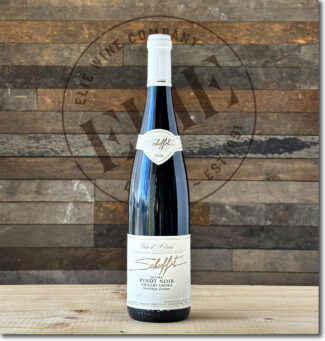 •6• Domaine Schoffit ‘Vieilles Vignes Vendange Entière’, 2018 Alsace Pinot Noir ($33)
•6• Domaine Schoffit ‘Vieilles Vignes Vendange Entière’, 2018 Alsace Pinot Noir ($33)
‘Vendange Entière’ refers to whole-cluster fermentation—a cellar technique intended to make a given wine more complex, weaving in spicy and herbal while adding candied and airy fruit and tannin structure, and also, to smooth out high acidity. In short, it is a method winemakers use to override anything lacking in a cool climate Pinot. Here, it works, and the wine is finely knit, featuring crushed black cherry, mandarin orange peel, Herbes de Provence and anise notes.
Crémant d’Alsace
Under Pressure
Alsace contains three individual AOPs: The general Alsace AOP to cover white, rosé and red wines; Alsace Grand Cru AOP for white wines from certain classified vineyards, and the newest kid on the block—Crémant d’Alsace AOP for sparkling wines—a designation made formally effective in1976. From this latter region comes 30 million bottles of sparkling wine per year, a staggering figure until you compare it to Champagne’s 300 million bottles.
As in the Grand Crus of Alsace, Crémant AOP is riddled with rules, some stricter than Champagne. Among them, allowed varieties are Auxerrois, Chardonnay, Pinot Blanc, Pinot Gris, Pinot Noir and Riesling, and unlike Champagne, Rosé may only be made from Pinot Noir. Additionally, the harvest must come grapes have to come from vines into its 3rd growing season and the wine may not be bottled for the second fermentation before January 1 of the year after the harvest. The wine must then spend at least 12 months ‘sur latte’ before disgorging. It is—like Champagne—required to be made via Méthode traditionnelle.
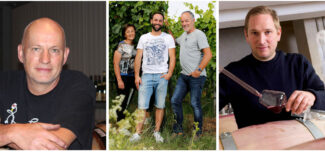
left to right … Jacky Barthelmé, Sébastien Mann and parents, Valentin Zusslin
The following superb examples of lyrical Crémant d’Alsace are available in a three-bottle pack for ($110).
Jacky Barthelmé (Domaine Albert Mann)
Wettolsheim is a hamlet a few miles west of Colmar, but it is still biggest wine village of the Haut Rhin by vineyard surface area. It is also the nexus of Domaine Albert Mann, the joint efforts of two big winemaker families, Mann and Barthelmé. The Manns have been winegrowers since the beginning of the 17th century and Barthelmés since 1654; today’s generation is led by brothers Maurice and Jacky Barthelmé and their wives, Marie-Claire and Marie-Thérèse.
The domain’s 50 acres are spread across eight communes where the soil structures are specifically suited to the style of wine produced, including silica to offer vivacity, clay to add mineral notes, limestone for richness and marl to preserve acidity. Among the family’s commitment to preserving the estate’s remarkable terroir are a vigorous replanting of old vines to maintain diversity, allowing grass to grow between every other row while a horse ploughs the rest, and the use of natural compost to encourage the formation of humus and to aid with the assimilation of minerals in the subsoil.
Say Marie-Thérèse Barthelmé: “Wine is the grape’s memory.”
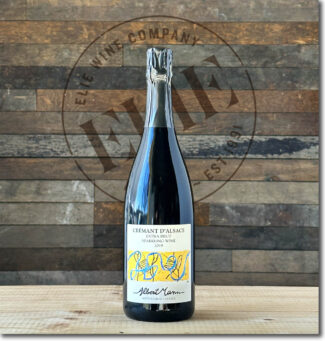 •1• Domaine Albert Mann, 2019 Crémant d’Alsace ($36)
•1• Domaine Albert Mann, 2019 Crémant d’Alsace ($36)
Hand-harvested from Kientzheim and Wettolsheim, this blend of Pinot Blanc and Auxerrois shows lightly toasted brioche, tangerine and white cherry with a fine mousse and charming textures, fringed with meringue and jasmine-blossom tea.
Sébastien Mann (Domaine Mann)
After stints in Côte-Rôtie and Champagne, where he learned the value of biodynamics from Bertrand Gautherot, Sébastien Mann has been making wine at the family estate since 2009 after taking over for his father. He says, “I think that thanks to biodynamics, we have succeeded in bringing an additional element to our vines. My father made wines essentially linked to the earth; I have an even more holistic style, linked to the stars.”
Domaine Mann’s 32 acres were founded upon the theory that in order to produce terroir-driven wines with aging potential, legally allowable yields have to be cut in half. From the outset, the estate produced 35 cuvées, one for each parcel.
“The style of the wines changed very quickly when I came on board,” Sébastien maintains. “95% of the wines we produce now are dry. It was not an easy task, since Alsace is one of the warmest and driest regions in France. Grapes can easily ripen with a high sugar level. I don’t think my father could imagine that with biodynamics we would be able to achieve such a great evolution, achieving phenolic maturity while making dry wines.”
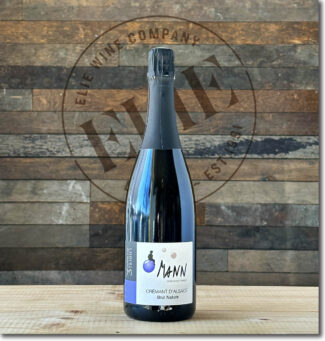 •2• Domaine Mann, 2018 Crémant d’Alsace Brut Nature ($35)
•2• Domaine Mann, 2018 Crémant d’Alsace Brut Nature ($35)
A blend of Auxerrois, Chardonnay and Pinot Noir, bone dry with zero dosage, leading to the designation ‘Brut Nature.’ It spends 30 months on lees, leading to luxurious creaminess, a characteristic of Mann sparkling wines. Notes of Golden Delicious apple play on the nose with a hint of white pepper shimmering in the background.
Valentin Zusslin (Domaine Valentin Zusslin)
Aligned with the same winemaking traditions it first established in 1691, Zusslin is located in the southern part of Alsace in Orschwir on the Bollenberg, Clos Liebenberg (a Zusslin monopole) and the hillsides of Pfingstberg Grand Cru.
Early to the Crémant game, the domain was also an early practitioner of biodynamics, having introduced this philosophy to viticulture in 1997. Says Valentin (whose name, perhaps, makes this an iconic sparkling wine for February 14): “We plant cover crops to encourage good insects and microbial life for the soil, encourage bees to pollinate the beneficial plants and we grow trees to attract the birds that eat the harmful bugs. This way of thinking carries through everything we do in the fields and in the winery.”
In addition, his wife Marie insists that their lifestyle goes far beyond a philosophy, and as evidence, she indicates the wall on the property that bears names of 13 generations of Zusslin winegrowers: “We represent not only history, but the circle of life.”
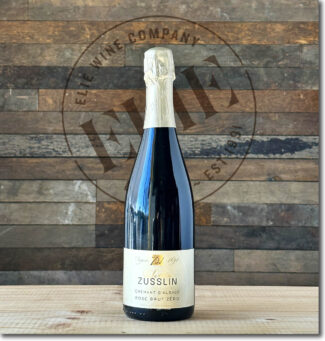 •3• Domaine Valentin Zusslin, nv Crémant d’Alsace Rosé Brut Zero ‘Natural’ ($39)
•3• Domaine Valentin Zusslin, nv Crémant d’Alsace Rosé Brut Zero ‘Natural’ ($39)
Another perfectly dry Brut Zero, and since it is forbidden for Crémant producers to blend red and white grapes to make rosé, this one is 100% Bollenberg Pinot Noir, created and bottled without sulfites. It is an elegant saignée rosé, with red berry aromas on the nose, intense fruit-skin intensity and a striking mineral profile to the finish.
Vintage Journal
2020
The 2020 growing season began with an unusually warm spring, which saw both an early budburst and flowering. The summer quickly picked up steam, but little rain—extremely hot conditions made drought a serious issue in some vineyards, as the delicate nature of Alsace white grapes means they are particularly sensitive to heat stress. There was enough intermittent rainfall to prevent the grapes from becoming completely parched, although the high temperatures inevitably sped up the growing season prompting an early harvest. Picking began in early autumn during a heatwave, which meant pickers had to be careful grapes were brought in under suitably cool conditions. Overall, despite the problems with drought, the harvest produced grapes in good condition, with their essential aromatics and acidities preserved.
2019
Overall, the 2019 vintage in Alsace was very good. Chilly spells during the spring were accompanied by the typical seasonal frosts in April. Temperatures began to warm up in May and hot weather in June and July eliminated both rot and mildew. Rain fell in August relieving the vines from drought and the good conditions continued for the September harvest. These conditions are ideal for offering grapes to develop concentration and depth without suffering drought-related stress.
2018
The first half of 2018 was characterized by unusually high rainfall which allowed the soils to build important reserves for the upcoming summer months. Surprisingly, despite the heavy rains, flowering was not only successful but arrived earlier than normal. A warm, dry summer saw temperatures spike in July, making the few light rains that fell in August quite welcome. Although the grapes tended to ripen more quickly than normal, the harvest still occurred at a leisurely pace over two months. All the whites delivered impressively, particularly wines made from Gewürztraminer, Muscat, Pinot Blanc and Sylvaner. However, Pinot Gris generally stole the show with beautifully rich, aromatic wines. Riesling was perhaps the trickiest, less suited to the warmer temperatures, but October’s warm days and cool nights helped the grapes to ripen while retaining their acidity, creating superlative Vendanges Tardives.
Notebook …
The Sugar Question: Sec Means Sec
“We’re not in favor of the change, especially for Riesling,” says Emanuelle Gallis of leading Alsace cooperative Cave de Turckheim. “But in the end, it’s not a catastrophe. It’s only one word—just another rule on top of all the others.”
That word is ‘sec’, meaning ‘dry’—a word which Alsace producers have been obliged to carry on the label of their dry wines since the 2016 vintage. This is the Association of Alsace Producers’ interpretation of a European Union law stipulating that one of four levels of sweetness should be carried on labels: sec, demi-sec, moelleux and doux; the AVA was concerned that consumers were turning away from Alsace wines because they were afraid of buying an off-dry or sweet wine when they wanted a dry one. “This has become particularly clear in Parisian brasseries,” says AVA president Jérôme Bauer, “where Alsace Rieslings are getting rarer.”
As a result of the new rule, dry Alsace wines must be labeled ‘sec’ if they have maximum four grams of residual sugar per liter—an INAO rule that had previously applied to all other French wine regions beside Alsace. Although it seems like a logical decision, it has not been embraced willingly by all producers, some of whom feel it is misguided, as the default style of Alsace whites is mineral dryness rather than sweetness.
- - -
Posted on 2023.03.01 in Crémant d'Alsace, France, Wine-Aid Packages, Alsace
Featured Wines
- Notebook: A’Boudt Town
- Saturday Sips Wines
- Saturday Sips Review Club
- The Champagne Society
- Wine-Aid Packages
Wine Regions
Grape Varieties
Aglianico, Albarino, Albarín Blanco, Albarín Tinto, Albillo, Aleatico, Arbanne, Aubun, Barbarossa, barbera, Beaune, Biancu Gentile, bourboulenc, Cabernet Franc, Cabernet Sauvignon, Caino, Caladoc, Calvi, Carcajolu-Neru, Carignan, Chablis, Chardonnay, Chasselas, Clairette, Corvina, Cot, Counoise, Erbamat, Ferrol, Fiano, Frappato, Friulano, Fromenteau, Fumin, Garnacha, Gewurztraminer, Godello, Graciano, Grenache, Grolleau, Groppello, Juan Garcia, Lambrusco, Loureira, Macabeo, Macabou, Malvasia, Malvasia Nera, Marsanne, Marselan, Marzemino, Melon de Bourgogne, Merlot, Mondeuse, Montanaccia, Montepulciano, Morescola, Morescono, Moscatell, Muscadelle, Muscat, Natural, Nero d'Avola, Parellada, Patrimonio, Petit Meslier, Petit Verdot, Pineau d'Aunis, Pinot Auxerrois, Pinot Blanc, Pinot Gris, Pinot Meunier, Pinot Noir, Poulsard, Prieto Picudo, Rondinella, Rousanne, Roussanne, Sangiovese, Sauvignon Blanc, Savignin, Semillon, Souson, Sparkling, Sumoll, Sylvaner, Syrah, Tannat, Tempranillo, Trebbiano, Trebbiano Valtenesi, Treixadura, Trousseau, Ugni Blanc, vaccarèse, Verdicchio, Vermentino, Viognier, Viura, Xarel-loWines & Events by Date
- April 2024
- March 2024
- February 2024
- January 2024
- December 2023
- November 2023
- October 2023
- September 2023
- August 2023
- July 2023
- June 2023
- May 2023
- April 2023
- March 2023
- February 2023
- January 2023
- December 2022
- November 2022
- October 2022
- September 2022
- August 2022
- July 2022
- June 2022
- May 2022
- April 2022
- March 2022
- February 2022
- January 2022
- December 2021
- November 2021
- October 2021
- September 2021
- August 2021
- July 2021
- June 2021
- May 2021
- April 2021
- March 2021
- February 2021
- January 2021
- December 2020
- November 2020
- October 2020
- September 2020
- August 2020
- July 2020
- June 2020
- May 2020
- April 2020
- March 2020
- February 2020
- January 2020
- December 2019
- November 2019
- October 2019
- September 2019
- August 2019
- July 2019
- June 2019
- May 2019
- April 2019
- March 2019
- February 2019
- January 2019
- December 2018
- November 2018
- October 2018
- September 2018
- August 2018
- July 2018
- June 2018
- May 2018
- April 2018
- March 2018
- February 2018
- January 2018
- December 2017
- November 2017
- October 2017
- September 2017
- August 2017
- July 2017
- June 2017
- May 2017
- April 2017
- March 2017
- February 2017
- January 2017
- December 2016
- November 2016
- October 2016
- September 2016
- August 2016
- July 2016
- June 2016
- May 2016
- April 2016
- March 2016
- February 2016
- January 2016
- December 2015
- November 2015
- October 2015
- September 2015
- August 2015
- July 2015
- June 2015
- May 2015
- April 2015
- March 2015
- February 2015
- January 2015
- December 2014
- November 2014
- October 2014
- September 2014
- August 2014
- July 2014
- June 2014
- April 2014
- March 2014
- February 2014
- January 2014
- December 2013
- November 2013
- October 2013
- September 2013
- August 2013
- July 2013
- June 2013
- May 2013
- April 2013
- March 2013
- February 2013
- January 2013
- December 2012
- November 2012
- October 2012
- February 2004
Search



